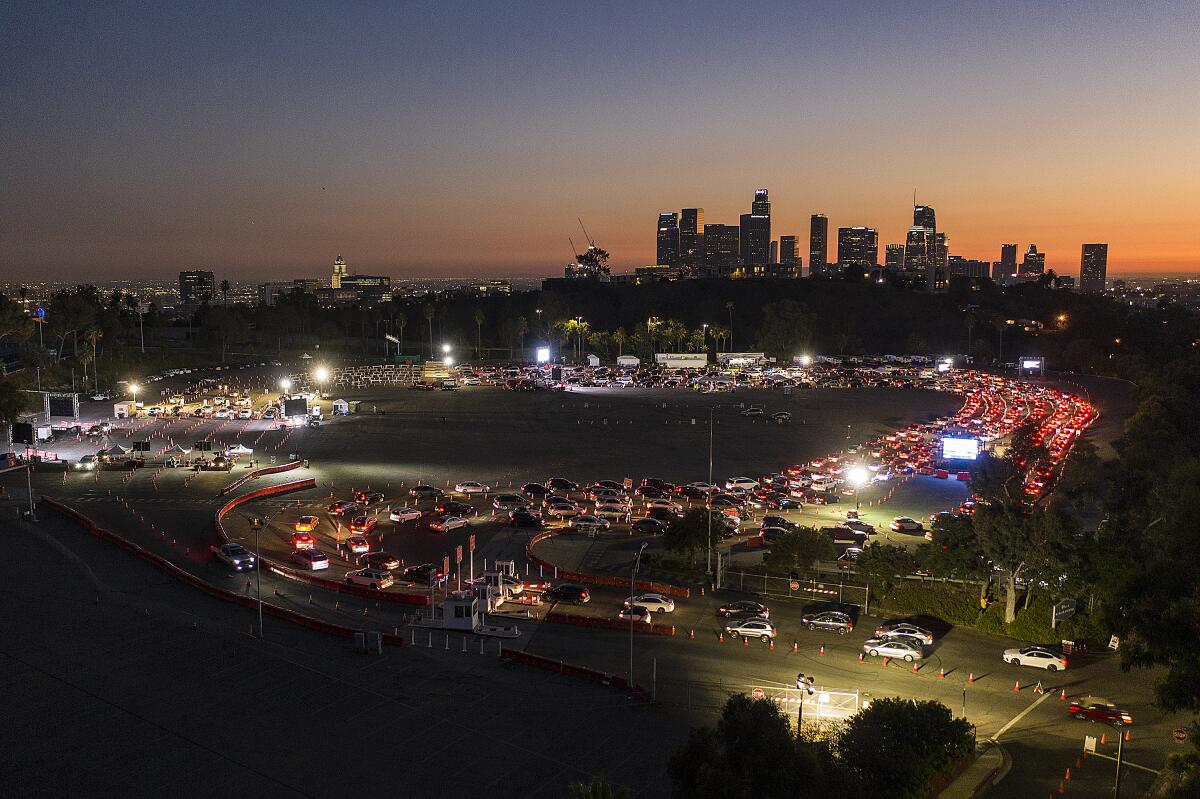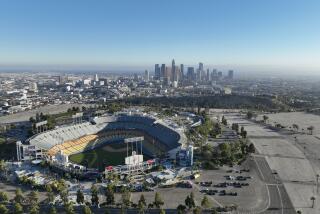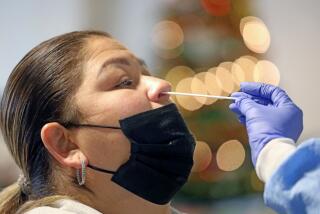Residents’ complaints about traffic temporarily closed Dodger Stadium COVID testing site. It reopens Monday

- Share via
The coronavirus testing site at Dodger Stadium will reopen Monday after being closed over the weekend for restructuring in a bid to cut down on traffic, which has drawn complaints from neighborhood residents, officials said.
Long lines of cars could often be seen snaking around the massive drive-through testing site, which the city has described as the largest in the nation, and spilling into adjacent streets.
“We were receiving a few complaints from neighbors in the area that traffic was hindering, on some days, their ability to do daily activities,” said David Ortiz, public information officer for the Los Angeles Fire Department. “So we took that into advisement and planned out with the Dodgers a way to improve the situation.”
The Dodgers made an additional parking lot available. Fire Department personnel and engineers with the Los Angeles Department of Transportation used traffic cones to create four meandering lanes for cars to travel through, “which takes the traffic off city streets and puts it on the Dodgers property,” Ortiz said.
Officials estimate the changes will result in more than 600 vehicles being rerouted from surrounding streets each day, he said.
The testing site was shut down Saturday so workers could bring in thousands of traffic cones, lighting and generators to complete the work. It was also closed Thursday and Friday for the New Year’s holiday. The testing site will reopen Monday and operates Monday through Saturday from 8 a.m. to 8 p.m.
The site, operated by the city of L.A. in partnership with the L.A. Fire Department, the Dodgers, Curative and the nonprofit Community Organized Relief Effort, has administered more than 1 million tests since May, Mayor Eric Garcetti said. It now has the ability to perform 13,300 tests a day, Ortiz said.
“It’s important to note that even though the vaccine has started to be made available to healthcare workers, we don’t want to let our guard down,” Ortiz said. “We want to make sure that we are following all the protocols of masks, social distancing, washing our hands and testing to make sure that we are safe and we are keeping our neighbors safe as well.”
That comes as L.A. County continues to report a surge in coronavirus infections. Public health officials said new cases are accelerating at the fastest pace since the start of the pandemic. L.A. County has added 400,000 new coronavirus cases in just over a month. It took the county 10 months, from Jan. 26 to Nov. 30, to tally its first 400,000 cases.
And the toll continues to worsen.
On Sunday, an additional 11,513 new coronavirus cases were reported in the county, according to a Times count of local health jurisdictions. Over the last three days, L.A. County has reported an average of about 16,000 new coronavirus cases a day, one of the highest such numbers in the pandemic.
Also, an additional 85 COVID-19 deaths were reported Sunday, the latest in a grim holiday season that saw the highest single-day death tallies in the last week, including 242 on Tuesday, 262 on Wednesday, 291 on New Year’s Eve, and 193 on New Year’s Day.
Combined, 184 deaths have been reported on average every day over the last week, the highest such number on record — the equivalent of a death every eight minutes.
January will be “the darkest month we will have,” Garcetti said Sunday.
Hospitalizations continued to crest: There were 7,697 COVID-19 patients in L.A. County hospitals as of Saturday, according to data released by the state Sunday, an increase of 783 people from the Saturday before.
In another worrying trend, Garcetti said, more people who do not have underlying health conditions are dying of COVID-19. Earlier in the pandemic, about 92% of people who died had preexisting health conditions; that number has now dropped to about 86%, officials said.
“So, my message to everybody is this is not only going to come for somebody that you love,” Garcetti said Sunday on CBS’ “Face the Nation.” “This is going to possibly come for you. And so everything we do is either lifesaving or life-taking at this point.”
More to Read
Sign up for Essential California
The most important California stories and recommendations in your inbox every morning.
You may occasionally receive promotional content from the Los Angeles Times.











